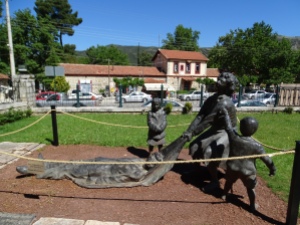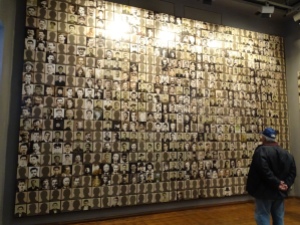May 2016
The train ride from Diakofto to Kalavrita is spectacular. It takes about an hour to go up the mountain and until Zachlorou we are going through the Vouraikos Gorge with impressive views and stunning rides over ridges and through tunnels. Last time, I walked along the train track back to Diakofto. This time I take the train and go all the way up to Kalavrita, which is situated on the banks of the Vouraikos river at Mount Chelmos. On the way up, the train is fully booked with 40 school children, screaming “wows” the whole journey. It is hard to make nice pictures, sitting in the front wagon with the windows closed. There are signs everywhere that you are not allowed to open the windows, as the air conditioning is on. On the way back I suddenly noticed that we all have an assigned seat and mine is in the last wagon, according to my ticket. We are with three people and immediately we open up the windows, trying to get some nice shots, while hanging out of the train. You do have to watch carefully, when the train is entering a tunnel or going over a bridge, as the track is very narrow and you could end up beheaded or without a camera!
I visited Kalavrita before, but always in winter time and always for an outing in the snow. I have always known the story about the terrible suffering of the people here, during the Second World War. This time I want to know more about the history of this sad story, which is considered one of the cruelest atrocities of the WW2 in Europe. I will visit the Holocaust Museum in Kalavrita and later the monument on the hill of Kapi ridge.
At the end of 1943, 81 German soldiers, led by Hauptmann Johannes Schober, were captured by Greek Partisans near Kerpini village. Four Germans were killed on the spot and three were taken to the hospital at Kalavrita, but later shot by furious Partisans. All the others were treated as prisoners of war. Two prisoners escaped and raised the alarm. On December the 8th, the German troops destroyed the villages Kerpini and Pogi and killed their male population. Soon after this took place, the Greek resistance executed the German prisoners. During the following days, German troops entered Kalavrita to look for the Greek resistance soldiers. Although the villagers affirmed them that the Greek forces had left, the Nazi troops ordered on the 13th of December 1943 all the residents to the school building. They separated men and boys from the women. All the male residents of Kalavrita, aged 13 years and older then had to gather in a field on Kapi hill and they were gunned down. From the 468 people, 13 survived. After the Massacre of Kalavrita, the German troops burned down the town and the next day also the Monastery of Agia Lavra, birthplace of the Greek War of Independence.
The Cathedral in Kalavrita was later rebuilt, but the left clock remains stopped at the time, when the crime began; at 14.34 p.m.
In total more than 1200 civilians were killed in Kalavrita and it’s neighbouring villages and around 1000 houses were looted and burned down.
The Monastery of Mega Spileo, around 10 km outside of Kalavrita, was burnt by the German Nazis and all 22 monks and staff members were killed and their bodies were thrown over the cliffs.
The Holocaust museum is small, but very impressive and informative. Interviews, with the survivors of the Massacre, can be seen on a television screen. Various photographs of the people of this town, taken during special occasions, are displayed. Personal items of the fallen and German objects are also demonstrated.
The last room has one big wall covered with pictures of the fallen and I am standing there looking at all those faces, who once lived peacefully in this tiny town in the mountains. A Greek man, who came to visit for the first time, is looking for a relative who was among the fallen. One of the staff members helps him finding the picture which belongs to the name.
After my visit to the museum I walk out of town up to Kapi Hill, from where an enormous cross is overlooking the valley of Kalavrita. Underneath are the monuments with the names and ages engraved of the men and boys killed on the 13th of December, 1943.
I am the only visitor at his moment and it a beautiful sunny day. I sit myself down at the bottom of the cross and look over the valley and the mountains and stay for quite a while………It is difficult to imagine all what happened here, on this very spot, on the 13th of December 1943.






















